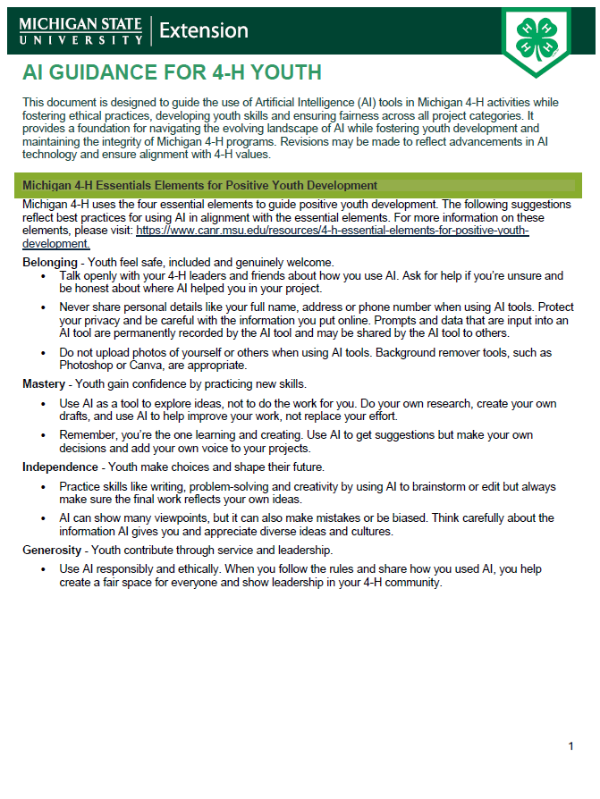
AI Guidance for 4-H Youth
DOWNLOADSeptember 30, 2025 - Michigan State University Extension
This document is designed to guide the use of Artificial Intelligence (AI) tools in Michigan 4-H activities while fostering ethical practices, developing youth skills and ensuring fairness across all project categories. It provides a foundation for navigating the evolving landscape of AI while fostering youth development and maintaining the integrity of Michigan 4-H programs. Revisions may be made to reflect advancements in AI technology and ensure alignment with 4-H values.
This document should be used in collaboration with the AI Guidance for 4-H Volunteers resource.
Michigan 4-H Essentials Elements for Positive Youth Development
Michigan 4-H uses the four essential elements to guide positive youth development. The following suggestions reflect best practices for using AI in alignment with the essential elements. For more information on these elements, please visit: https://www.canr.msu.edu/resources/4-h-essential-elements-for-positive-youth-development.
Belonging - Youth feel safe, included and genuinely welcome.
- Talk openly with your 4-H leaders and friends about how you use AI. Ask for help if you’re unsure and be honest about where AI helped you in your project.
- Never share personal details like your full name, address or phone number when using AI tools. Protect your privacy and be careful with the information you put online. Prompts and data that are input into an AI tool are permanently recorded by the AI tool and may be shared by the AI tool to others.
- Do not upload photos of yourself or others when using AI tools. Background remover tools, such as Photoshop or Canva, are appropriate.
Mastery - Youth gain confidence by practicing new skills.
- Use AI as a tool to explore ideas, not to do the work for you. Do your own research, create your own drafts, and use AI to help improve your work, not replace your effort.
- Remember, you’re the one learning and creating. Use AI to get suggestions but make your own decisions and add your own voice to your projects.
Independence - Youth make choices and shape their future.
- Practice skills like writing, problem-solving and creativity by using AI to brainstorm or edit but always make sure the final work reflects your own ideas.
- AI can show many viewpoints, but it can also make mistakes or be biased. Think carefully about the information AI gives you and appreciate diverse ideas and cultures.
Generosity - Youth contribute through service and leadership.
- Use AI responsibly and ethically. When you follow the rules and share how you used AI, you help create a fair space for everyone and show leadership in your 4-H community.
Best Practices for AI Use
- Brainstorming: Use AI to help you come up with ideas or explore different possibilities. AI can help you think outside the box and spark your creativity. You are still the one making the final decisions.
- Writing: AI can help organize your thoughts, improve your grammar and spelling, and suggest better ways to say something. If you use AI for writing, be clear that it was part of your process by citing the AI source (see How to Cite AI section below). AI writing should not be presented as your own. Think of AI as your helpful writing buddy, but not the author.
- Photos, images and video: AI tools can help you edit photos or videos you’ve taken or create new images based on your ideas. If you use AI to create media, be honest about it. AI is a tool to support and enhance your creativity, not replace your critical thinking or expertise.
- Research and learning: AI can help you find information quickly and explain things in simple ways. AI can also make mistakes, so your own thinking and research are still important. Always double check facts from trusted sources.
Key Concepts with AI Use
- AI can suggest ideas, but it doesn’t know everything. Use your own judgement and critical thinking skills to decide what makes sense. Don’t be afraid to challenge what AI says.
- Always be honest about how you use AI. Whether it helped you brainstorm, write, edit or create something, let others know. If a project, contest or class does not allow AI usage, do not use AI in your work for that project. This builds trust and shows you are using AI responsibly.
In Project Areas
- Public Speaking: Write your own speech. AI can assist, but your originality reflects authenticity and personal effort.
- Arts & Media: Show how AI helped but your creative choices should shine, embodying authentic work and responsible use.
- Creative Writing: Use AI as a brainstorming tool, but write in your voice, honoring the value of authentic expression.
- Applications & Awards: AI can help fine-tune, which is resource-savvy, but your ideas must come from you to reflect growth and integrity.
How to Cite AI
In project write-ups or posters
- “ChatGPT was used to brainstorm ideas for this project (OpenAI, 2025).”
- “Image editing using Canva AI Background Remover (Canva, 2025).”
In speeches or presentations
- “I used AI to help me edit my draft, but the ideas and final work are my own.”
In project journals or records
- “I asked ChatGPT to help me outline my report and then wrote the draft myself.”
This document was created with the assistance of ChatGPT, an artificial intelligence tool developed by OpenAI, and was reviewed and edited by Michigan 4-H staff for accuracy and alignment with program values.



 Print
Print Email
Email




